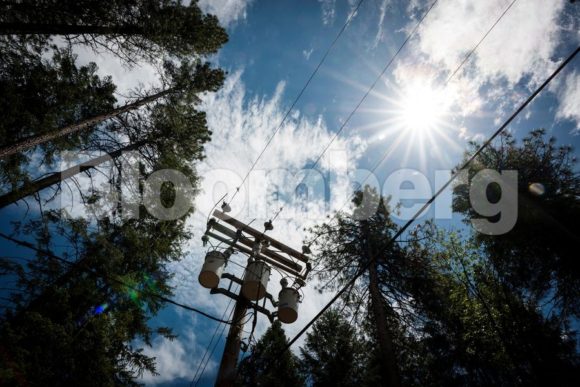Winds are dying down. Utility giant PG&E Corp. has begun inspecting lines. And yet an unprecedented blackout that has taken out power to dozens of cities around San Francisco still threatens to leave millions of people in the dark for days.
More than 600,000 homes and businesses remained without electricity across the Bay Area on Thursday, even as the weather improved. PG&E has begun the lengthy process of inspecting power lines, mile by mile, but has yet to say when people can expect to emerge from the largest blackout ever orchestrated to prevent high winds from knocking down electrical lines and igniting wildfires. The economic impact of the event may reach $2.6 billion.
After being forced into bankruptcy from wildfires its equipment caused over the past two years, PG&E is using the massive power cuts in an attempt to prevent another deadly disaster. While San Francisco and most of Silicon Valley have been spared, the extensive reach of the outages in Oakland, San Jose and elsewhere is roiling the area’s economy by disrupting workers, shutting stores and forcing companies and agencies to shell out for costly back-up generators to keep operations limping along.
As it grappled with the outages, PG&E got hammered on Wall Street Thursday. Its shares plunged29% after a judge stripped it of exclusive control over its restructuring. The ruling threatens to puts the company’s fate into the hands of bondholders who are proposing to all but wipe out the stakes of existing shareholders.
Meanwhile, a small blaze broke out south of San Francisco on a hillside beneath PG&E power lines in city of Brisbane. The fire burned about 5 acres and was was roughly 50% contained, city officials said. PG&E shares briefly fell to a near-session low when the blaze was reported but then recovered.
In Oakland, long strips of banks, pharmacies, delis, coffee shops and other businesses were closed. Trucks arrived on Thursday morning to deliver boxes of fresh seafood to restaurants that had nowhere to store them. Wells Fargo had shuttered some branches as of Wednesday, and a few dozen Safeway supermarkets were affected, with the company supplying backup generators and refrigerated trailers upon availability.
In Southern California, Edison International had cut off about 12,900 customers in counties including Los Angeles and Kern. The utility is warning that almost 174,000 customers remain at risk. San Diego’s main utility is also considering cutting service to about 34,000. Altogether, more than 3 million people may eventually be affected, or almost 8% of the state’s population, based on city estimates and the average household size.
Restoring Power
Determining just how deep the impact will be is difficult. While PG&E has restored power to about 126,000 customers, the company wasn’t saying Thursday when the rest could expect service back. It instead offered this: “The number of circuit-miles requiring inspection includes nearly 25,000 miles of distribution lines and 2,500 miles of transmission lines, a combined distance measuring longer than a trip around the circumference of the Earth.”
The company issued an “all clear” in parts of Northern California where about 270,000 people have lost power. That means the utility will start inspections and repairs there before restoring service. The company expected “dangerous weather” to continue through parts of the Sierra Foothills and Bay Area until midday Thursday.
The Alameda County Sheriff Department said on Twitter that the county, home to Berkeley and Oakland, was among those that PG&E will start inspecting. “Power not will turn on until inspections are complete,” it said.
Outages could persist into next week as crews walk the lines. Some local officials have warned a shutoff could last seven days.
Parts of Northern California’s East and South Bays lost power late Wednesday as part of a second phase of shutoffs. PG&E turned off service to another 4,000 in parts of Kern County early Thursday. The utility earlier predicted impact to 43,000.
A prolonged blackout will strain the region’s economy, said Michael Wara, director of the Climate and Energy Policy Program at Stanford University. Blackouts lasting hours or a single day close offices and schools, and prompt runs on grocery stores. At five days, cupboards start running bare, diesel for backup generators start selling out and gasoline runs short as stations won’t have power.
California Spends Most on Its Electric Grid: It’s Not Enough
Running on Generators
For wineries, the blackout hit at a crucial time: harvest. Michael Haney, executive director of Sonoma County Vintners, said many wineries have either bought or rented backup generators. Some smaller growers have struck agreements to have their grapes stored at other facilities where there’s power.
“Wineries have had to pay out money for backup power,” he said. “The sad thing is some of our smaller wineries can’t afford it.”
The widespread impact angered Californians — and some elected officials. State Senator Scott Wiener, a San Francisco Democrat, called the outage “a completely unacceptable state of affairs.” Governor Gavin Newsom was more measured, saying the blackout was “appropriate under the circumstances,” but added: “No one is happy about it.”
Was this article valuable?
Here are more articles you may enjoy.


 Poll: Consumers OK with AI in P/C Insurance, but Not So Much for Claims and Underwriting
Poll: Consumers OK with AI in P/C Insurance, but Not So Much for Claims and Underwriting  California Sees Two More Property Insurers Withdraw From Market
California Sees Two More Property Insurers Withdraw From Market  Synopsys Sued by Private Equity Firm for Shopping $3 Billion Unit
Synopsys Sued by Private Equity Firm for Shopping $3 Billion Unit  CoreLogic Report Probes Evolving Severe Convective Storm Risk Landscape
CoreLogic Report Probes Evolving Severe Convective Storm Risk Landscape 